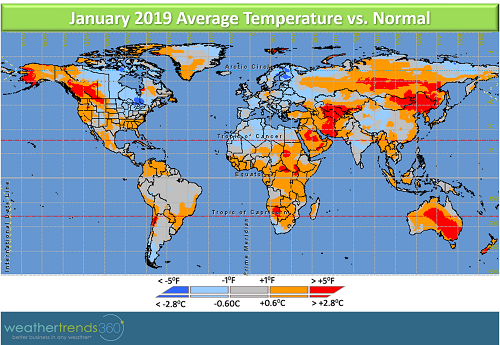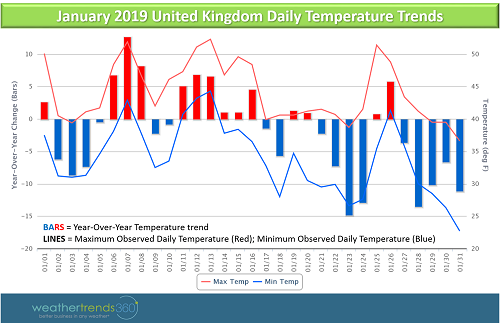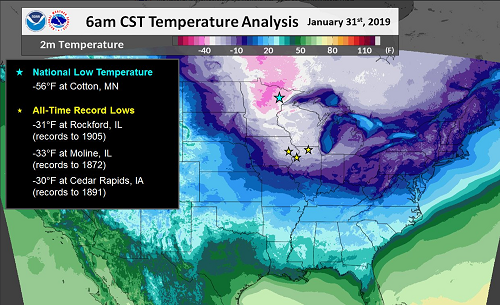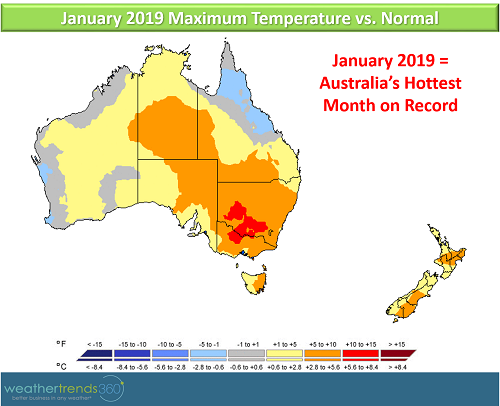January 2019 World Weather Review
Did You Know?
January, a month both deep in the winter season for the Northern Hemisphere and deep in the summer season for the Southern Hemisphere. Being at the pinnacle of what is typically the coldest (Northern Hemisphere) and hottest (Southern Hemisphere) time of year, any temperature extremes that occur during this time frame are sure to be noticed. While temperature extremes were some of the big stories this month, there was at least one unusual severe weather event that briefly stole the spotlight from temperature extremes.
 In the Northern Hemisphere, the star weather feature was the Polar Vortex disruption which sent very cold, Arctic air down across parts of Europe and North America breaking hundreds of cold temperature records. While January started out relatively mild in the eastern half of the U.S., temperatures turned dramatically colder by the last 10-12 days of the month as the full effect of the Polar Vortex was realized. Portions of Europe, including the United Kingdom, also saw a drop in temperatures towards the latter part of the month.
In the Northern Hemisphere, the star weather feature was the Polar Vortex disruption which sent very cold, Arctic air down across parts of Europe and North America breaking hundreds of cold temperature records. While January started out relatively mild in the eastern half of the U.S., temperatures turned dramatically colder by the last 10-12 days of the month as the full effect of the Polar Vortex was realized. Portions of Europe, including the United Kingdom, also saw a drop in temperatures towards the latter part of the month.
 Temperatures were as much as -56F across parts of northeastern Minnesota during the peak of the Polar Vortex intrusion with wind chills even lower than that!
Temperatures were as much as -56F across parts of northeastern Minnesota during the peak of the Polar Vortex intrusion with wind chills even lower than that!
 While the Polar Vortex froze North America and Europe, in the southern half of the globe, record heat baked Australia. In fact, the Australia Bureau of Meteorology confirmed that January 2019 was the hottest month on record for the country, this comes on the heels of the hottest December on record. All kinds of temperature records were broken across Australia in January, including a record 46.6C temperature in Adelaide which was a new record high temperature for an Australian capital city. According to the Bureau, an unusual extended period of heatwaves over much of Australia began in early December 2018 and continued into January 2019. Brushfires were reported across parts of the country due to the extreme heat and dry conditions.
While the Polar Vortex froze North America and Europe, in the southern half of the globe, record heat baked Australia. In fact, the Australia Bureau of Meteorology confirmed that January 2019 was the hottest month on record for the country, this comes on the heels of the hottest December on record. All kinds of temperature records were broken across Australia in January, including a record 46.6C temperature in Adelaide which was a new record high temperature for an Australian capital city. According to the Bureau, an unusual extended period of heatwaves over much of Australia began in early December 2018 and continued into January 2019. Brushfires were reported across parts of the country due to the extreme heat and dry conditions.
 Australia's neighbor, New Zealand, also saw hotter than normal temperatures and this was the 2nd hottest January in 28+ years (only colder than last year, which was the hottest January in 28 years). Temperatures were also well above normal in Brazil where this was the 2nd hottest January in 28+ years.
Australia's neighbor, New Zealand, also saw hotter than normal temperatures and this was the 2nd hottest January in 28+ years (only colder than last year, which was the hottest January in 28 years). Temperatures were also well above normal in Brazil where this was the 2nd hottest January in 28+ years.
While extreme temperatures stole most of the headlines there were some instances of extreme severe weather around the World. Most notably, a strong EF-4 tornado that ripped straight through the Cuban capital of Havana on January 27th. The deadly tornado, which the Cuban Center for Meteorology estimated the winds to be in the 155-199 mph range, injured nearly 200 people as it rampaged through Havana at night and caused significant damage. The tweet below shows surveillance video of the tornado.
 In the Northern Hemisphere, the star weather feature was the Polar Vortex disruption which sent very cold, Arctic air down across parts of Europe and North America breaking hundreds of cold temperature records. While January started out relatively mild in the eastern half of the U.S., temperatures turned dramatically colder by the last 10-12 days of the month as the full effect of the Polar Vortex was realized. Portions of Europe, including the United Kingdom, also saw a drop in temperatures towards the latter part of the month.
In the Northern Hemisphere, the star weather feature was the Polar Vortex disruption which sent very cold, Arctic air down across parts of Europe and North America breaking hundreds of cold temperature records. While January started out relatively mild in the eastern half of the U.S., temperatures turned dramatically colder by the last 10-12 days of the month as the full effect of the Polar Vortex was realized. Portions of Europe, including the United Kingdom, also saw a drop in temperatures towards the latter part of the month. Temperatures were as much as -56F across parts of northeastern Minnesota during the peak of the Polar Vortex intrusion with wind chills even lower than that!
Temperatures were as much as -56F across parts of northeastern Minnesota during the peak of the Polar Vortex intrusion with wind chills even lower than that! While the Polar Vortex froze North America and Europe, in the southern half of the globe, record heat baked Australia. In fact, the Australia Bureau of Meteorology confirmed that January 2019 was the hottest month on record for the country, this comes on the heels of the hottest December on record. All kinds of temperature records were broken across Australia in January, including a record 46.6C temperature in Adelaide which was a new record high temperature for an Australian capital city. According to the Bureau, an unusual extended period of heatwaves over much of Australia began in early December 2018 and continued into January 2019. Brushfires were reported across parts of the country due to the extreme heat and dry conditions.
While the Polar Vortex froze North America and Europe, in the southern half of the globe, record heat baked Australia. In fact, the Australia Bureau of Meteorology confirmed that January 2019 was the hottest month on record for the country, this comes on the heels of the hottest December on record. All kinds of temperature records were broken across Australia in January, including a record 46.6C temperature in Adelaide which was a new record high temperature for an Australian capital city. According to the Bureau, an unusual extended period of heatwaves over much of Australia began in early December 2018 and continued into January 2019. Brushfires were reported across parts of the country due to the extreme heat and dry conditions. Australia's neighbor, New Zealand, also saw hotter than normal temperatures and this was the 2nd hottest January in 28+ years (only colder than last year, which was the hottest January in 28 years). Temperatures were also well above normal in Brazil where this was the 2nd hottest January in 28+ years.
Australia's neighbor, New Zealand, also saw hotter than normal temperatures and this was the 2nd hottest January in 28+ years (only colder than last year, which was the hottest January in 28 years). Temperatures were also well above normal in Brazil where this was the 2nd hottest January in 28+ years.While extreme temperatures stole most of the headlines there were some instances of extreme severe weather around the World. Most notably, a strong EF-4 tornado that ripped straight through the Cuban capital of Havana on January 27th. The deadly tornado, which the Cuban Center for Meteorology estimated the winds to be in the 155-199 mph range, injured nearly 200 people as it rampaged through Havana at night and caused significant damage. The tweet below shows surveillance video of the tornado.
[TORNADO CUBA] Nuevo vÃdeo del #tornado EF4 que impactó La Habana, #Cuba el domingo, 27 enero alrededor de 8:30 pm (velocidad rápida de video). Vea movimiento (derecha a izquierda) y gotas agua en alta velocidad. Informe actualizado con Dr. José Rubiera https://t.co/H46PvpN0dB pic.twitter.com/meC1ioNj64
— Ada Monzón (@adamonzon) February 1, 2019